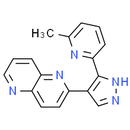Description
RepSox (E-616452 or SJN 2511) is a highly potent, selective inhibitor of the TGF-β type I receptor ALK5 with IC50 of 23 nM and 4 nM for ATP binding to ALK5 and ALK5 autophosphorylation, respectively. It has good selectivity for ALK5 over a range of kinases, including p38 MAPK, JNK1 and GSK3 (IC50 > 16 μM). RepSox is able to successfully replace Sox2 in reprogramming by inhibiting transforming growth factor-β (Tgf-β) signaling, which in turn induces Nanog expression. Effect of RepSox inducing reprogramming does not require chromatin remodeling. RepSox is found to be efficient at generating iPSCs.
Product information
CAS Number: 446859-33-2
Molecular Weight: 287.32
Formula: C17H13N5
Chemical Name: 2-(5-(6-methylpyridin-2-yl)-1H-pyrazol-4-yl)-1,5-naphthyridine
Smiles: CC1=CC=CC(=N1)C1NN=CC=1C1=CC=C2N=CC=CC2=N1
InChiKey: LBPKYPYHDKKRFS-UHFFFAOYSA-N
InChi: InChI=1S/C17H13N5/c1-11-4-2-5-16(20-11)17-12(10-19-22-17)13-7-8-14-15(21-13)6-3-9-18-14/h2-10H,1H3,(H,19,22)
Technical Data
Appearance: Solid Power.
Purity: ≥98% (or refer to the Certificate of Analysis)
Solubility: DMSO up to 100 mM
Shipping Condition: Shipped under ambient temperature as non-hazardous chemical or refer to Certificate of Analysis
Storage Condition: Dry, dark and -20 oC for 1 year or refer to the Certificate of Analysis.
Shelf Life: ≥12 months if stored properly.
Stock Solution Storage: 0 - 4 oC for 1 month or refer to the Certificate of Analysis.
Drug Formulation: To be determined.
HS Tariff Code: 382200
How to use
In Vitro:
RepSox was used at 1-25 µM final concentration in vitro and in stem cell reprogramming.
In Vivo:
RepSox is able to be contribute to forming chimeric embryos in vivo when injected into blastocysts. A one-day treatment with RepSox is sufficient to replace transgenic Sox2.
References:
- Gellibert F, et al. Identification of 1,5-naphthyridine derivatives as a novel series of potent and selective TGF-beta type I receptor inhibitors. (2004) J Med Chem. 47(18):4494-506.
- Ichida JK, et al. A small-molecule inhibitor of tgf-Beta signaling replaces sox2 in reprogramming by inducing nanog. (2009) Cell Stem Cell. 5(5):491-503.
- Li W, et al. Generation of rat and human induced pluripotent stem cells by combining genetic reprogramming and chemical inhibitors. (2009) Cell Stem Cell. 4(1):16-9.
- Liu X, et al. Sequential introduction of reprogramming factors reveals a time-sensitive requirement for individual factors and a sequential EMT-MET mechanism for optimal reprogramming. (2013) Nat Cell Biol. 15(7):829-38.
- Hou P, et al. Pluripotent stem cells induced from mouse somatic cells by small-molecule compounds. (2013) Science. 341(6146):651-4.
Products are for research use only. Not for human use.
Documents
Payment & Security
Your payment information is processed securely. We do not store credit card details nor have access to your credit card information.


